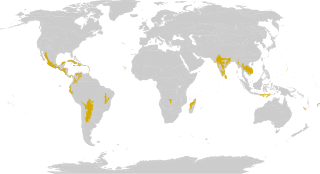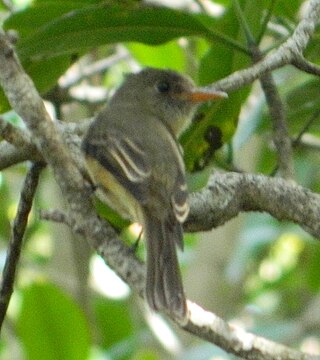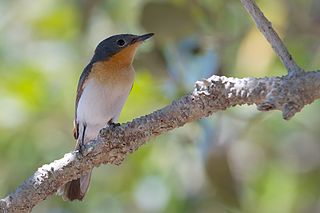
The tropical and subtropical dry broadleaf forest is a habitat type defined by the World Wide Fund for Nature and is located at tropical and subtropical latitudes. Though these forests occur in climates that are warm year-round, and may receive several hundred centimeters of rain per year, they have long dry seasons that last several months and vary with geographic location. These seasonal droughts have great impact on all living things in the forest.

The Sula megapode or Sula scrubfowl is a species of bird in the family Megapodiidae. It is found only in the Banggai and Sula Islands between Sulawesi and the Maluku Islands in Indonesia, where its habitats are subtropical or tropical dry forest, subtropical or tropical moist lowland forest, subtropical or tropical mangrove forest, and subtropical or tropical moist shrubland. It is threatened by habitat destruction.

The dark-backed imperial pigeon is a species of bird in the family Columbidae. It is endemic to the Lesser Sunda Islands.

The pink-headed imperial pigeon is a species of bird in the family Columbidae found in the Lesser Sunda Islands of Indonesia. Its natural habitats are subtropical or tropical moist lowland forests, subtropical or tropical mangrove forests, and subtropical or tropical moist shrubland. It is threatened by habitat loss.

The Lesser Antillean pewee is a species of bird in the family Tyrannidae.

The pale-shouldered cicadabird or Sumba cicadabird is a species of bird in the family Campephagidae. It is endemic to the Lesser Sunda Islands of Indonesia. Its natural habitats are subtropical or tropical moist lowland forest and subtropical or tropical moist montane forest.

The black-fronted flowerpecker is a species of bird in the family Dicaeidae. It is endemic to the Lesser Sunda Islands in Indonesia. Its natural habitats are subtropical or tropical moist lowland forest and subtropical or tropical moist montane forest.

The blue-cheeked flowerpecker or red-chested flowerpecker is a species of bird in the family Dicaeidae. It is found on the Lesser Sundas. Its natural habitats are subtropical or tropical moist lowland forest and subtropical or tropical moist montane forest.

The blood-breasted flowerpecker is a species of bird in the family Dicaeidae. It is found in the Lesser Sunda Islands. Its natural habitats are subtropical or tropical moist lowland forest and subtropical or tropical moist montane forest.

The Wallacean drongo or Greater Wallacean drongo is a species of bird in the family Dicruridae. It can be found in the countries of Indonesia and East Timor. It was formerly considered to be conspecific with the hair-crested drongo.

The Caribbean elaenia is a species of bird in the family Tyrannidae found in the West Indies and parts of Central America. Its natural habitats are tropical and subtropical dry broadleaf forest, subtropical or tropical moist lowland forest, and heavily degraded former forest.

The lesser necklaced laughingthrush is a species of bird in the family Leiothrichidae.

The crested white-eye or crested ibon is a species of bird in the family Zosteropidae. It is endemic to the Lesser Sunda Islands.
The greater melampitta is a species of bird in the family Melampittidae. It is the only species in the genus Megalampitta, although it was once placed in the genus Melampitta with the lesser melampitta. Formerly classified as a bird-of-paradise, the little-known greater melampitta has an uncertain taxonomy and is sometimes believed to be affiliated to pitohuis, as it appears to be poisonous to eat . It is found in New Guinea. Its natural habitats are subtropical or tropical moist lowland forests and subtropical or tropical moist montane forests.

The spectacled monarch is a species of bird in the family Monarchidae. It is found in Australia, Indonesia, and Papua New Guinea. Its natural habitats are subtropical or tropical moist lowland forests, subtropical or tropical mangrove forests, and subtropical or tropical moist montane forests.

The broad-billed flycatcher is a species of bird in the family Monarchidae. It is found in northern Australia, the Lesser Sunda Islands and southern New Guinea. Its natural habitats are subtropical or tropical moist lowland forest, subtropical or tropical mangrove forest, and subtropical or tropical moist montane forest.

The Wallacean whistler is a species of bird in the family Pachycephalidae. It is native to the eastern Lesser Sunda Islands. Its natural habitats are subtropical or tropical moist lowland forests and subtropical or tropical mangrove forests.

The bare-throated whistler is a species of bird in the family Pachycephalidae. It is endemic to the Lesser Sundas.

The pygmy cupwing or pygmy wren-babbler, is a species of bird in the Pnoepyga wren-babblers family, Pnoepygidae. It is found in southern and eastern Asia from the Himalayas to the Lesser Sunda Islands. Its natural habitats are subtropical or tropical moist lowland forest and subtropical or tropical moist montane forest.
The brown-capped fantail is a species of bird in the family Rhipiduridae. It is found in the Lesser Sunda Islands.


















